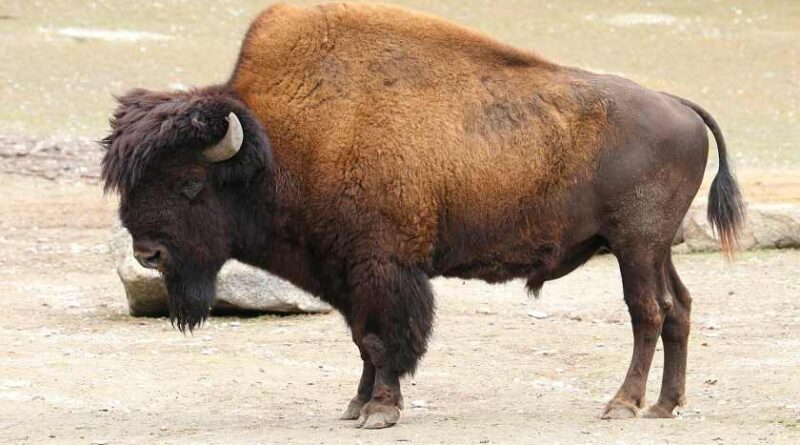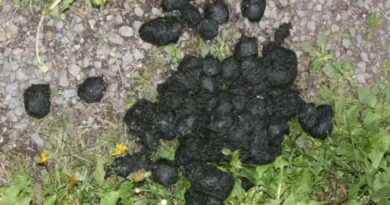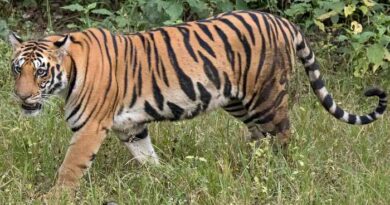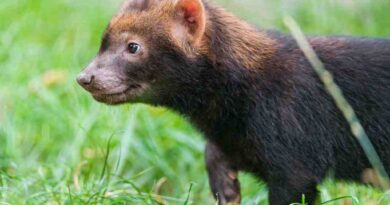Bison
The bison is the largest of all North American land animals. A large guy weighed about 1,000 kilogrammes. The enormous plains of North America were teeming with them before the coming of the white man. The massive herds might stretch for over 50 miles and were frequently so densely packed that the plains appeared dark. The bison’s huge head is slung low over its massive shoulders. A pair of short, curving horns with inward-pointing points are present. A shaggy beard grows beneath the jaws, and the fur on the humped shoulders is long and thick, almost like a lion’s mane.
The’mane’ reaches down around the front legs, giving the impression that they are wearing hairy pants. The animal’s back end, on the other hand, has significantly shorter hair. The bison’s coat is arranged in such a way that it can keep warm by turning into the wind.
Every year, enormous herds of literally millions of these animals migrate north for the summer and then south for winter grazing when the weather turns cold. They travelled several hundred kilometres on each trip.
They mated every summer, and the cows gave birth to their reddish-colored calves every spring. The calves did not have the same large meaty humps as the adults when they were born. The juvenile animals’ humps did not begin to grow until they were about three months old. After one year of weaning from their mothers’ milk, the young adults would begin mating at two to three years of age and, assuming no mishaps or wolf attacks, might expect to live for roughly thirty years. The flies and ticks that infected the herds’ thick hair were the herds’ deadliest foes in the early days.
The bison did their best to fend off the pests by digging big mud puddles in which they could roll around and bathe in the therapeutic mud. They utilised dust-wallows instead of mud when it was too dry for mud. To soothe their skin irritations, they also rubbed themselves against trees or rocks. When the pests were very bothersome, the heavy-bodied bison would attack the trees with such vigour that they would gravely damage or even destroy them. When the first American Indians appeared on the scene, the bison herds were confronted with a new foe. The flesh of the bison was superb because it was a grass-eating member of the cattle family. Many Indians moved to the American prairies and began hunting bison.
The herds took control of their entire way of life. They wrapped their homes in bison skins, wore bison garments, slept under bison blankets, sat on bison rugs, and crossed rivers in bison-skin canoes, in addition to eating bison meat. They also received string for their bows, glue, thread, rope, water vessels, and saddles from the animals.
Despite the fact that they had to kill a large number of bison with their traps and bows and arrows, there were far too few of these Indians to seriously harm the herds. The animals could reproduce quickly enough to compensate for their losses. There was still a natural equilibrium in place. But all of that would alter when their next adversary, the white man, arrived.
There were between 60 and 100 million bison in North America before European people arrived. After the entrance of guns, the population fell to 40 million people. But this was just the start. There was about to be a mass bloodbath. It’s hard to believe, but millions of bison were reduced to only a few hundred animals in just twenty years. Some sources say it’s 541, while others say it’s 835. A whole species has almost vanished from the face of the earth. It was the most heinous act of wildlife annihilation ever perpetrated. What caused that to happen? There was more to come. Due to a multitude of reasons
When we see a Wild West movie in the theatre and see cowboys and Indians battling, we imagine this is how newcomers ‘won the West,’ but it wasn’t the case. Simply put, the West was conquered by going out to eliminate the bison herds. When new settlers from Europe arrived in the homelands of the American Indians, the first thing they saw was how dependent the people were on bison. They witnessed how products derived from these animals supported their entire culture. All the newcomers needed to do was shoot the bison, and the Indians would be defeated. That’s exactly what happened, and it happened in a flash.
Even in areas where the Indians were not a concern, bison were killed for a variety of reasons, including meat, clothing, and sport. The new farmers had an additional motivation: they had brought their domestic cattle with them, and these freshly imported grass-eaters required the plains to feed on. The bison had to be killed for this reason as well. In addition, the railways that were being built from east to west cut right across bison habitat. It was a great challenge to lay these routes over such vast distances and through such harsh terrain. Hundreds of thousands of men were participating, toiling hard in the scorching sun. The work was hard, and the men required nutritious meals in order to perform at their best. To feed their work, the railway firms hired special hunters who were proficient at killing neighbouring bison.
Buffalo Bill was the most famous bison hunter of all time. The bison was given the name “buffalo” by the locals. “I killed buffalo for the railroad business for twelve months and at that period,” he wrote of his work under his true name, William Cody. ‘I had slaughtered 4,280 buffalo.’ Of course, there were a lot of them. They butchered almost a million bison a year between them, until there were just a few lonely stragglers left alive. The bison’s day had come to an end.
Fortunately, the few remaining people were rescued before it was too late. They were safeguarded and used as the starting point for a large-scale rescue mission. They had bred so well at the turn of the century that their numbers were back up into the thousands. in Today, about 31,000 bison may be found in specific game reserves and parks across North America, where people can observe them and try to imagine what 100 million bison must have looked like. We were on the verge of eradicating the bison forever, but there is a happy ending this time, and these majestic animals are now secure for the future.



